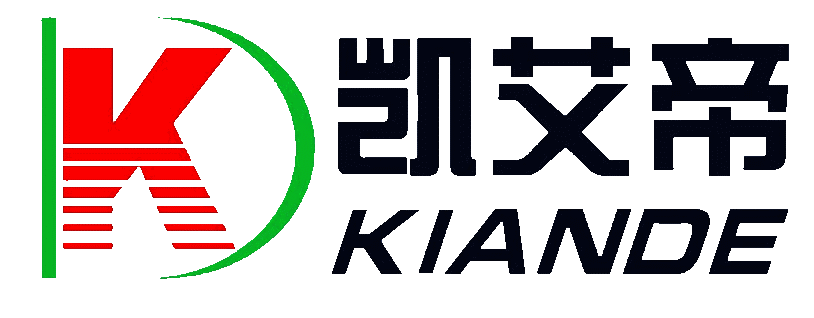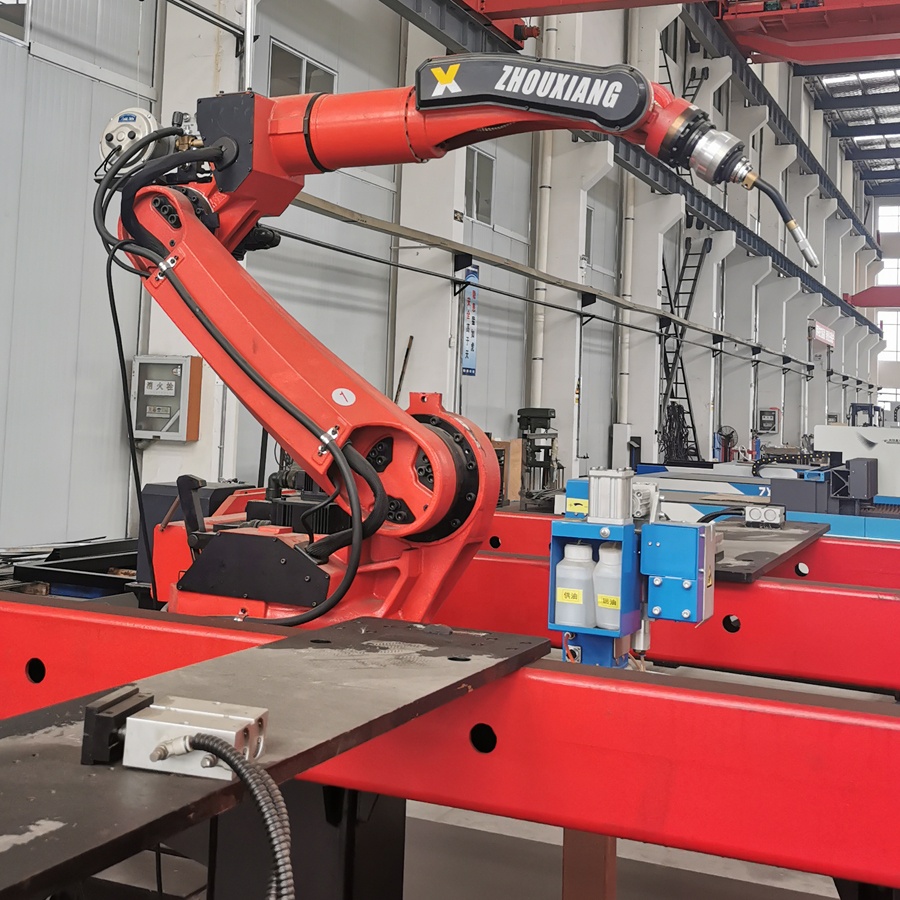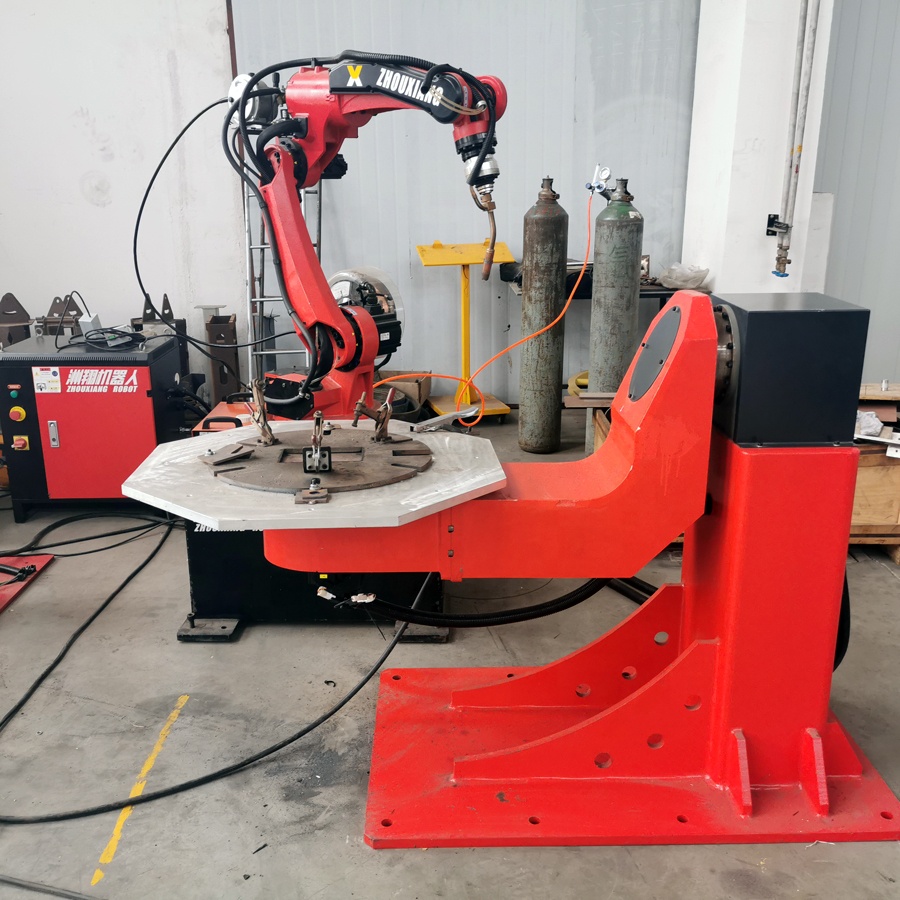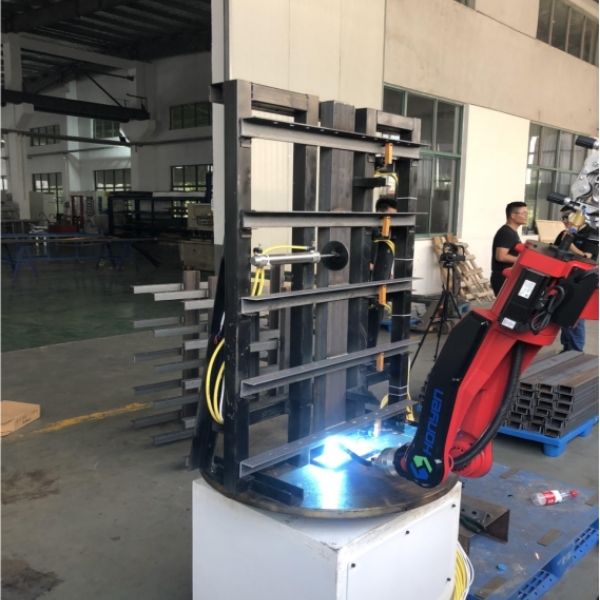High-speed Welding Robot Automatic Welding Machinery
1) The carrying capacity of the robotic arm can reach 20kgs.
2) Improved acceleration performance by using rigidity arm and advanced servo technology, shortening the action time and realizing the high inefficiency.
3) Wrist arm adopts special driving mechanism and realized slim wrist with built-in cables
4) Special flexible conduit for cable wiring (option) is available.
5) Decrease the training time by using “ROBOGUIDE” offline programming
6) Intelligent application functions are available with built-in vision or force sensors
7) The design of high-speed welding robots meets the requirements of high welding speed and positioning accuracy.
8) It adopts a new welding control system. The software is developed by our company and the hardware adopts a high-performance DSP+ FPGA chip.
High-speed Welding Robot Automatic Welding Machinery Specifications :
| Brand Name | KIANDE |
| Place of Origin | China |
| Min.Order Quantity | 1 |
| Machine Type: | Welding Manipulator |
| Core Components: | Motor, control system, welding machine |
| Weight (KG): | 300KG |
| Usage: | welding |
| Max linear speed: | 1500mm/s |
| Repeat positioning precision: | ±0.08mm |
| Voltage: | 380V 50Hz 3P |
| Max. load capacity | 20kg |
| Freedom of movement | 6axis |
| Maximum working radius | 1.8m |
| Welding capacity | High-quality welding 0.8 ~ 12mm carbon steel, 0.5 ~ 4mm stainless steel, |
| Welding material | Carbon steel, stainless steel, galvanized sheet |
High-speed Welding Robot Automatic Welding Machinery Detail Introduction :
High-speed welding robots have been used in manufacturing for decades, however, advances in technology have seen these machines speeding up and becoming cheaper. The technology is nowhere and KIANDE Used Robots even builds robots in-house, making them tailor-made for each client. It can not only meet but also exceed all standards of shipbuilding pipe welding. Used to weld HIC, DCD, LSAW, SMAW and UHPW, etc. (NOTE: I've also included a more detailed description -- including images)
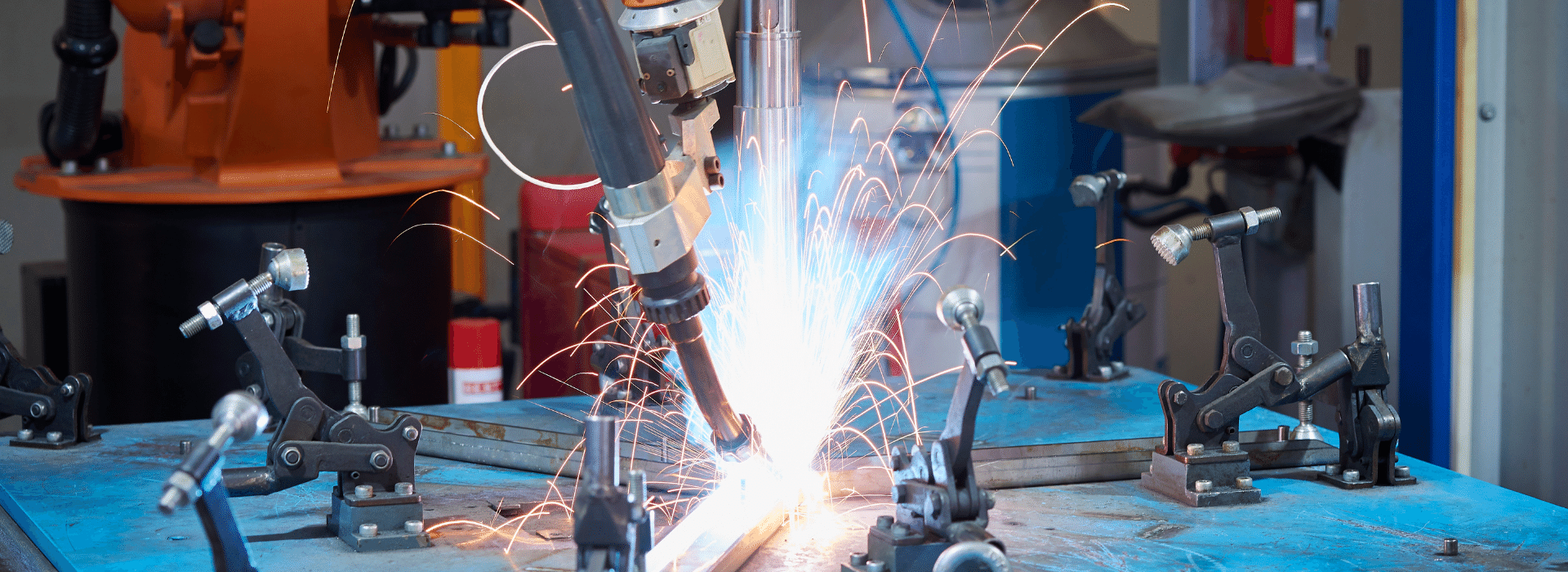
What is High-speed Welding Robot?
The welding robot is an automatic device that uses the arc as a heat source to melt the filler metal and joins the two parts together, and it can control all or part of the welding process according to the program. High-speed welding robots with fast welding speed, stable welding quality, easy operation, easy maintenance, and strong anti-interference ability.
The high-speed welding robot has many advantages such as large working space, high precision, good repeatability, stable structure, no pollution, and high-cost performance. At present, in the application of various industries at home and abroad, the proportion of automatic welding is very high. With the advancement of technology and continuous innovation of technology, it will become more and more widely used in various fields of industry.
High-speed Welding Robot Features
high speed welding robot are widely used in the industrial field. The following is a brief introduction of High-speed Welding Robot Features:
The carrying capacity of the robotic arm can reach 20kgs
The carrying capacity of the robotic arm Welding Robot can reach 20kgs, and each axis can carry 100 kg. It is suitable for various complex environments such as welding, cutting, loading and unloading, spraying, polishing, etc. The series of products are widely used in automobile manufacturing, shipbuilding, pressure vessel manufacturing, machine tool manufacturing, and metal processing industries
Improved acceleration performance by using rigidity arm and advanced servo technology, shortening the action time and realizing the high inefficiency
The rigidity arm is used to improve the structural rigidity of the machine, reduce the impact of external interference on motion, ensure that each part of the machine can work in the best state, and improve production efficiency.
In addition, the use of advanced servo control technology, can shorten the action time and realize high-efficiency production.
Wrist arm adopts special driving mechanism and realized slim wrist with built-in cables
The robot's wrist arm adopts a special driving mechanism and realized a slim wrist with built-in cables. This has drastically reduced the interference to the work environment when robot arms are working in close proximity. The slim wrist has also made it possible to place two robot arms side by side on the same surface, thus enabling a wide range of working patterns.
A special flexible conduit for cable wiring (option) is available
1.Excellent flexibility, easy bending, simple installation, and resistant to cracking from vibration.
2.Polyolefin material (flame retardant).
3.The special heat-resistant sleeve protects the cable from being damaged by heat generated by the inner power cable.
Decrease the training time by using “ROBOGUIDE” offline programming
ROBOGUIDE, developed by FANUC, is software that allows the simulation of tasks performed by industrial robots. The software is used to work out applications and teach robots how to perform certain tasks. This offline programming software is equipped with a 3D simulation of a controller and the ability to simulate the movement of the robot.
It offers full control of ROBOGUIDE simulation activities and has built-in features such as fast and accurate collision detection, real-time machine vision processing, and automated error checking.
Intelligent application functions are available with built-in vision or force sensors
A new generation of programmable robots is making industrial automation more accessible to companies of all sizes, and the UR3e collaborative robot from Universal Robots is leading the way.
The company's collaborative robots are designed to work side by side with production workers, performing a wide range of simple but repetitive tasks in an effort to increase productivity and efficiency while improving product quality.
The design of high-speed welding robots meets the requirements of high welding speed and positioning accuracy
The robot is designed as a six-axis articulated robot, which has a large working space and can realize three-dimensional space motion. The robot has a maximum working radius of 3200mm and a maximum load of 20kg. The robot can realize high-speed welding in all directions. The maximum welding speed is 1500 mm / s, which can ensure the high efficiency of the welding process.
The robot adopts an intelligent control system that controls the speed and position of the manipulator according to different processes. S7-300 series PLC is used for control, which can effectively eliminate interference during processing and improve product quality. the manipulator has high positioning accuracy, repeat positioning accuracy is ±0.2mm, effectively improving welding accuracy and reducing welding defects to achieve stable production efficiency.
The robot adopts a special arc force algorithm, which improves the stability of the arc, reduces spatter, and makes it easier to clean up after production.
It adopts a new welding control system. The software is developed by our company and the hardware adopts a high-performance DSP+ FPGA chip
The control performance is improved from the aspects of the algorithm, software, and hardware. It consists of a laser power supply, mechanical device, and electric control system. The laser power is controlled by a high-performance IGBT inverter with constant current characteristics.
The control circuit adopts isolation type optical coupling isolation and digital signal isolation to control various functions such as output start/end time setting, output power setting, output frequency setting, and waveform selection.
The operating interface is very friendly, which can intuitively reflect the operation status, alarm state and parameters of the equipment.
What are the components of a High-speed Welding Robot?
Before going to the topic we will explain what is a robot. A robot is a machine capable of performing tasks that humans can do. The robot has artificial intelligence that performs the task. Now, let us come to the topic.
A welding robot consists of different parts and components. The main components of a welding robot are:
1)Robot body
2)Controller
3)Welding source
4)End effector
5)Power supply
6)Motion control system
Which industries use high-speed welding robots?
High-speed welding robots are often used in industries that require high-volume, repetitive manufacturing. In the automotive industry, robotics have increased the frequency of robotic welding by reducing the costs and production time.
In recent years, industrial robots have become a common sight in many industries, including automotive, pharmaceuticals, logistics, food processing, and packaging. The use of robots has enabled manufacturers to increase productivity and reduce costs by eliminating waste.
It can be used for spot welding, projection welding, and seam welding?
High-speed welding robot can be used for spot welding, projection welding, and seam welding. It has the characteristics of high precision, fast operation speed, good stability and strong anti-interference ability.
The professional spot welding machine is composed of a YAG laser generator, a laser optical system, a CNC (computer numerical control) system, a cooling system and an electric control system. It mainly uses the principle of heat conduction to transmit laser energy to the surface of the workpiece through the spot welding head and concentrate on one point. The energy is converted into thermal energy to achieve the purpose of solder joint melting.
What types of materials can be processed with high-speed robotic welders?
High speed robotic welding is used to process a variety of materials from both sheet and bulk form. For sheet metal, the material thickness usually ranges from 0.3 mm to 3 mm, while for bulk materials, the size usually ranges from 10 mm to 500 mm. Specific examples include aluminum alloy, stainless steel, high-strength steel, copper alloy, nickel alloy and titanium alloy. Some high-end products also set special requirements on the shape of workpiece, such as curved surface or complex structure.
These materials are processed by robots in a variety of industries including aerospace, automotive, shipbuilding and nuclear power.
High-speed robotic Welding effect
The sales associate told me that the company has been developing products with the high-speed robotic Welding effect, and it has been effective and practical. This can greatly improve the quality of work, but also save a lot of manpower and material resources, do not need to use a lot of gas, and will not have a lot of waste, in terms of all aspects are very good.

High-speed Welding Robot VS Ordinary Mobile Welding Robots
Mobile robots are divided into two types: common mobile welding robots and high-speed mobile welding robots, although they have the same name, but their advantages and disadvantages are different.
The advantages of the ordinary mobile welding robot are: the price is low; the fault rate is low, easy to repair; the flexibility is good, suitable for short-range transportation of goods within the factory. The disadvantage is that the speed of movement is slow, usually only up to 80-120m/min, which can not adapt to the requirements of large batch production.
The ordinary mobile welding robot must be equipped with a fixed wire rack or track to ensure stable movement and control during operation.
As we all know, high-speed mobile welding robots have high speed (usually 300m/min or more), high stability and strong controllability. This type of equipment does not require fixed wire racks or tracks for operation. It has a larger working range than ordinary mobile welding robots and can move freely in space. Its biggest advantage is that it can adapt to large batch production requirements and reduce labor costs for enterprises.
